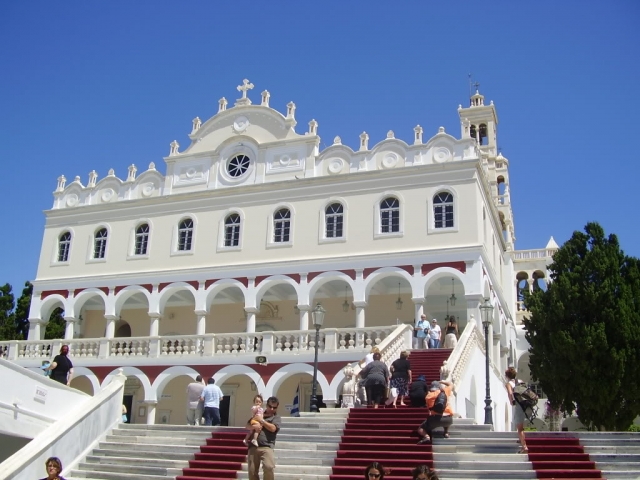Anastasia Balezdrova
The Assumption is a great Christian feast. It is officially celebrated in Greece and is often called "Summer Easter."
Each year, pilgrims set off to the churches of the Holy Virgin, which are scattered throughout the country. The churches on the islands of Tinos and Paros and the Pontic Virgin of Soumela in northern Greece attract the highest number of people. According to tour operators, however, the tourist flow will decrease this year. Data are not yet available but it is believed that the drop will be at least 30 and could reach 50 per cent.

The Assumption Monastery on the Island of Tinos. Some pilgrims climb the stairs on their knees to worship the Mother of God.
"Having in mind that there are vacant hotel rooms and available tickets for the ships to Tinos even on the eve of the feast, we can rightly assume that the number of visitors will be significantly lower than in previous years," said Nikos Kelaiditis for GRReporter, who is a board member of the Hellenic Association of Travel and Tourism Agencies (HATTA). This is because the majority of worshipers are Greeks. And they find it difficult to go on the annual pilgrimage because of their cut incomes.
However, there is an interest in Greek religious sites from abroad and not only from countries with orthodox religion. "There are researchers from Japan, Korea and other countries who are interested in visiting the various churches. There are people who are simply interested in the Byzantine culture and the religious sites of that time," said Nikos Kelaiditis. However, as he pointed out, religious tourism in Greece has not yet developed although it offers great opportunities.
"The situation is still better than it was two or three years ago. Things may improve as long as the government departments, the Church and the local businessmen organize themselves and start collaborating. Attempts were launched two years ago but they did not continue despite the great interest and involvement in the beginning."

The Church of Ekatondapiliani on the Island of Paros
According to Nikos Kelaiditis, the Church has manifested a great willingness and proposed many different ideas to implement the programme. As in most cases, the inaction of public authorities has again interrupted the initiative in taking the right actions for the development of an alternative type of tourism that could bring significant revenue to those involved in the chain.
"People who come to visit religious sites do not come only for 1-2 days. They stay much longer. They bring revenue not only to hotel and restaurant keepers and transport companies but also to local shops. This means that a local society can be fully occupied with this activity."
There are many places to be visited. A significant part of the way of Apostle Paul is connected with Greece; there are various monasteries in different parts of Greece. The rock monasteries of Meteora in the region of Thessaly are the most emblematic ones and the second in importance after those on Mount Athos.
Those willing to visit the monasteries of Mount Athos must obtain a permit, which is called diamonitirio and the authorities of Mount Athos issue it. The visitors, who can only be men, however, cease to be tourists upon arrival on the peninsula and are obliged to observe the programme of the monks. Furthermore, only a certain number of visitors are allowed in order to prevent overloading. "To monks, Athos is where they withdraw from our noisy world. Perhaps it is reasonable to prevent uncontrolled number of tourists. Some abbots and their representatives are not negative towards religious tourism but at the same time, they do not supportits large-scale development."
Nikos Kelaiditis added that many foreigners with large financial resources, who are not Orthodox Christians, are interested in visiting Mount Athos. "It is not easy for them to accept such a person, but it is not completely excluded. We had a customer – a banker from Singapore, who wanted to visit Mount Athos, as he was interested in the history of Byzantium. He visited Mount Athos for a day, without being allowed to stay in one of the monasteries and then, he went to the island of Patmos to visit the Monastery of Saint John and the Cave of the Apocalypse on the Island of Patmos."
According to representatives of the tourism business, the first and most important step in promoting religious tourism is the making of a database of the religious sites in each region.